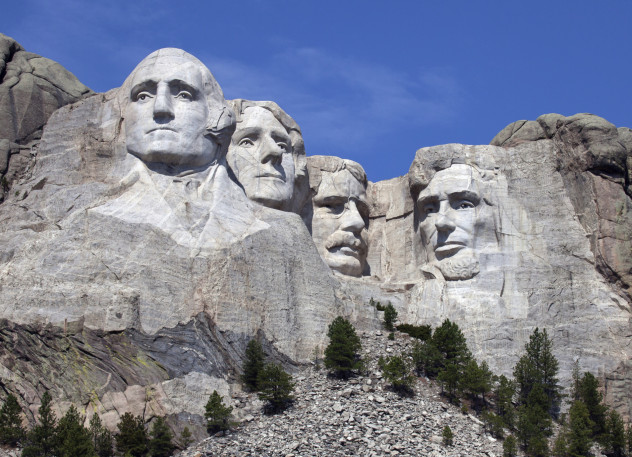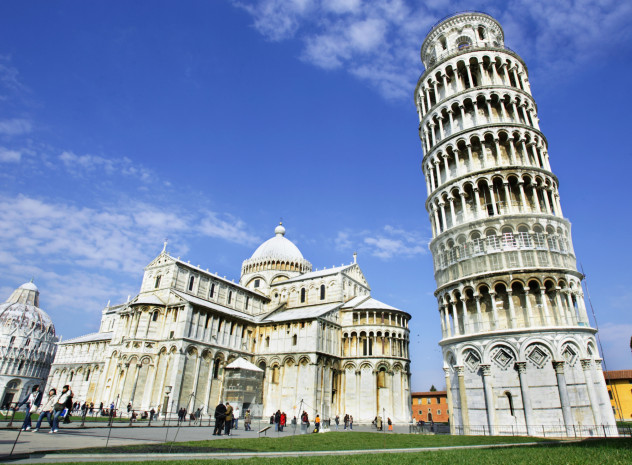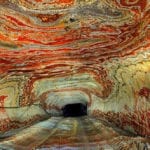 Animals
Animals  Animals
Animals  Weird Stuff
Weird Stuff 10 Weird Things That Warp Your Sense of Time
 Miscellaneous
Miscellaneous Ten More Extremely Unexpected U.S. State “Firsts”
 Humans
Humans 10 Ideas That Scare People to Death
 Music
Music The Cursed Decade: 10 Classic Rock Stars Who Had Low Periods in the 1980s
 Health
Health 10 Crazy Ways Sleep Deprivation Can Affect You
 History
History 10 Enthralling Facts about the Field of Cloth of Gold
 Pop Culture
Pop Culture The Ten Greatest Engineers in Science Fiction History
 Humans
Humans Ten Journalists Who Got Caught Faking the News
 Travel
Travel 10 Best Hiking Trails in America with Breathtaking Views
 Animals
Animals Ten Animals That Produce and Store Toxins in Unlikely Places
 Weird Stuff
Weird Stuff 10 Weird Things That Warp Your Sense of Time
 Miscellaneous
Miscellaneous Ten More Extremely Unexpected U.S. State “Firsts”
Who's Behind Listverse?

Jamie Frater
Head Editor
Jamie founded Listverse due to an insatiable desire to share fascinating, obscure, and bizarre facts. He has been a guest speaker on numerous national radio and television stations and is a five time published author.
More About Us Humans
Humans 10 Ideas That Scare People to Death
 Music
Music The Cursed Decade: 10 Classic Rock Stars Who Had Low Periods in the 1980s
 Health
Health 10 Crazy Ways Sleep Deprivation Can Affect You
 History
History 10 Enthralling Facts about the Field of Cloth of Gold
 Pop Culture
Pop Culture The Ten Greatest Engineers in Science Fiction History
 Humans
Humans Ten Journalists Who Got Caught Faking the News
 Travel
Travel 10 Best Hiking Trails in America with Breathtaking Views
10 Silly Myths About Famous Architectural Wonders
Beautiful buildings, enormous statues, and other amazing building projects of the past have long captured our collective imagination. The aesthetics of man-made wonders are something that we can all understand without the use of language at all, and they remind us on a visceral level what we are capable of as a species. Of course, due to language barriers—and good old misinformation—many people are left with misconceptions about some of the most famous architectural wonders of the world. Some of these myths are understandable, but others—like the ones below—are just downright silly.
10The Black Taj Mahal

Everyone is familiar with the beautiful structure that is the Taj Mahal in India, but they may not know much about its origin. It was originally built as a mausoleum by the Indian emperor Shah Jahan in the 1600s as a resting place for his wife, Mumtaz Mahal. The beautiful monument was made out of white marble, and it is a marvel of symmetry and engineering. The structure is still one of the most valued monuments in the world today, and it is a beloved tourist destination. Interestingly, some legends claim that the emperor originally planned for a much more ambitious project that would have blown everyone away.
The legends say that he really liked his symmetry, so right across the river from the first mausoleum for his wife, he intended to have a second gigantic structure built to encase his own remains when he shuffled off this mortal coil. This second structure was to be built entirely of black marble instead of white, and there would be a bridge across the river to connect the two structures together.
Some people claim that ruins found across the river (which include pieces of black marble) prove that construction was once begun and then abandoned. The stories say the construction was interrupted after one of the emperor’s sons took over, but scientists say the black marble that was found only ended up that way due to natural wear and not deliberate artifice. They have also pointed out that the emperor had plenty of time to enact such grand designs while he was alive but did not ever expend the effort to do so. It’s impossible to say if he may have had such an idea for sure, but there is no evidence anyone tried to act on such a plan.
9The Bodies That Support The Great Wall Of China

The Great Wall of China is home to many different myths. The most popular is probably that the wall is the only man-made object visible from outer space which, as we have pointed out before, is not at all true. However, there is a much more macabre myth about the Great Wall that is quite popular.
We know that building the Great Wall was a massive effort that likely involved millions of laborers over the years. Many of the people who worked on the wall were forced to, and many laborers died while working on the project. This has led to the myth that there are perhaps hundreds of thousands of people buried within the existing wall itself.
According to experts, this is extremely unlikely—though it’s hard to prove either way. They claim that it would have weakened the structure considerably, because the bodies would have formed air pockets as they decomposed within the walls.
However, there could be a certain element of truth to the story. Long before the current Ming Wall was built, there was another lost wall known as the Qin Wall. This wall’s construction was ordered by a tyrannical emperor of the same name. Some legends claim that so many died during the construction that they just dug mass graves and dropped the dead right in. However, even in these legends the dead are not actually entombed within the walls as that would have been a thoroughly impractical idea. They were simply buried close by as a matter of pure convenience—not to satisfy the whims of a crazy despot who thought a wall full of bodies was a good idea.
8Napoleon’s Strange Experience In Egypt

We have all heard the tales of the mummy’s curse. The stories will say that someone entered a tomb, disturbed the remains or took a sacred artifact, and was then cursed by the powers of a vengeful spirit. Of course, there is no evidence beyond anecdotes that there is any such thing as a mummy’s curse, but that has never stopped the storytellers. One tale claims that years ago when Napoleon was doing his thing, he was swinging by Egypt and wanted to take a look at the pyramids at Giza. In order to fulfill a particularly narcissistic desire, the self-styled Emperor wanted to spend the night in the pharaoh’s tomb in the Great Pyramid.
The stories claim that Napoleon stayed the entire night in the tomb as planned, but he looked terrified upon exiting the tomb the next morning. He then clammed up about the experience, and he did his best to never mention or talk about it again. According to legend, he almost considered telling all the details of what happened to him upon his deathbed, but he decided not to because he didn’t think anyone would actually believe his wild claims. Unfortunately, his secretary—who traveled with him—stated that Napoleon never spent the night in a tomb.
7Mount Rushmore Is A Racist Conspiracy

Mount Rushmore may seem like one of the most innocuous and least offensive monuments in the world—if not a little bit over the top—but it actually has a rather dark past. The Sioux lived in the area well before we ever considered chiseling out a gigantic stone likeness of several of our presidents on one of their mountains. To make matters worse, the Black Hills in particular—the region that houses that carving—are actually sacred land in the eyes of the Sioux.
As the wars with the native tribes continued, the Sioux slowly had more of their land annexed and were pushed back further and further until they had almost nothing left. This left the region open for a national monument, and it has since led to conspiracy theories about the intentions of the project.
The sculptor and man behind the final designs and subjects chosen for representation was named Gutzon Borglum, and some people suspect that the man had strong ties to the KKK—he worked on the Stone Mountain project in Georgia before he worked on Mount Rushmore. The theory goes that Borglum wanted to insult the native people and show them ultimate defeat having several US presidents carved on one of their sacred mountains.
Some people claim that others who backed the project originally wanted an Old West type of theme, sort of a Manifest Destiny thing, and even suggested the possible inclusion of a Native American like Crazy Horse, but Borglum was insistent on them all being white presidents who disliked the natives so he could further his agenda.
Of course, the monument was quite an undertaking and cost a lot of money. There is no evidence it was a concerted effort to insult the Sioux. The official reason for the monument from the beginning was to draw tourism to the region (which might be an indirect insult to the Sioux depending on how you look at it). However, the theory will likely persist as there is no way to know for sure what was in the mind of the artist. While Borglum could have possibly meant some insult, it is more likely he simply chose the subjects for his artwork that he personally found most important. Others would perhaps have chosen a different set of four presidents, or four other people altogether.
6Noah’s Ark Is On A Mountain In Turkey

Most people know the biblical tale of Noah’s Ark, wherein a great flood was foretold and God tasked Noah with building a ship that could withstand it and also hold two of each animal to later repopulate the Earth. Many Christians are convinced that this was not an allegorical story in the Bible but an event that literally occurred—and others take it much further still.
Some Christians believe that, despite all the thousands of years since it was supposed to have occurred, the ark is still somewhere to be found if only we look in the right place. They believe this would be a smoking gun that would prove to the world that they are right once and for all. Unfortunately for the theorists, their claims haven’t amounted to much.
The most popular claim is that it is somewhere on the peaks of Mount Ararat in Turkey, but some scholars have pointed out that the Bible only says it ended up somewhere in eastern Turkey and that the Ararat rumor came later.
Not long ago, yet another expedition returned claiming that they had found the ark, and it just so happened to be exactly at the location they expected. Carbon dating showed the wood at the site they found to be roughly 5,000 years old. The problem with their claims is that they have not been checked by professional archaeologists. What they found basically amounted to separated wooden compartments—more than likely the remains of a house of some kind—that they decided must be the ark. In any event, archaeologists don’t take the claims seriously. One expert even cheekily pointed out that he has never known of a group looking for the ark that didn’t claim a successful mission.
5The Leaning Tower Of Pisa Is Stable

The Leaning Tower of Pisa is one of the strangest landmarks in the world. It’s a famous tourist attraction known for being the building that looks like it’s about to fall over, but somehow it manages not to. You can even get novelty pictures making it look like you are trying to hold up the tower, so you can imagine most people wouldn’t take the threat of it falling over all that seriously.
In fact, some people think it’s mostly an optical illusion and that the building has very little real or dangerous lean to it at all. However, there is actually a commission tasked with the preservation of the tower, and they believe the tower has been in serious danger of falling over and ruining everyone’s day. The lean is actually a serious issue that continues to increase with time.
In an attempt to fix the problem, they have been trying new methods of soil extraction with a special drill on the north side of the tower. The hope is to balance out the structure’s foundation. While they have had some success so far—they managed to move it about 2.5 centimeters (1 in)—they also face some unique challenges. Despite the project to stabilize the tower and keep it intact for many generations, which costs millions, they also have to worry about the wrath of the public who doesn’t want them to “ruin” a national monument.
If they manage to fix the lean too much, there would be an outcry because it’s no longer the “leaning” tower. On the other hand, if they don’t stabilize it enough, it will eventually fall over. The men in charge of the commission believe that all the stabilizing work they have done so far, which includes more work on the foundation as well, has probably removed the current danger of it falling over, but its future remains uncertain. The foundation of the tower and the masonry itself are not in great shape.
4Jumping Off The Golden Gate Bridge Is An Easy Way To Die

The Golden Gate Bridge in San Francisco is one of the most easily recognizable landmarks in the world and a marvel of engineering. But that’s all overshadowed by the fact that it is one of the biggest suicide magnets in the world. It’s estimated that about 30 people die every year after jumping off the bridge, but the numbers are only an estimate—there could be people who jumped without others seeing them whose bodies were never recovered.
One of the reasons so many people jump off the bridge is because they think it is a quick and easy way to commit suicide—just one impact and it’s all over immediately. However, autopsy reports have shown it may not be quite so easy after all. To begin with, around 5 percent of people actually survive the jump. To make matters worse, some people do survive the initial fall but still die afterward due to a combination of drowning and horrific injuries—punctured lungs and bleeding brains are just some of the things a jumper can look forward to.
There is another more pervasive myth, though, that is keeping the problem from being fixed, and it could even be helping the suicide numbers increase. There really isn’t much of a barrier to stop people from jumping, and behavioral scientists believe this is the main reason it is such a suicide magnet.
Unfortunately, most people don’t understand the psychology of suicide, and think that if there were a barrier or net in place to make it more difficult that people would just commit suicide elsewhere, and erecting such a barrier would simply be a waste of taxpayer money. A study done on the subject of bridge suicides showed this was simply not true. Of the people who survived the fall off the Golden Gate Bridge, 90 percent of them did not go on to attempt suicide ever again. Suicide is usually a very spur-of-the-moment action.
As a matter of fact, many of the survivors even pointed to the ease with which one can jump off the bridge as part of their reason for choosing the location and attempting suicide in the first place. Unfortunately, this second myth likely is indeed costing lives because not enough people think making the suicide attempts more difficult will help.
3Lava Flow During The Destruction Of Pompeii

Most people know the story of the destruction of Pompeii quite well. The city was buried under mountains of ash after the unexpected eruption of Mount Vesuvius. The resulting eruption basically obliterated all life in the city and ruined everyone’s day. Remarkably, due to the manner in which the disaster happened, the remains of the city and its people were incredibly well-preserved, giving archaeologists and historians an incredible treasure trove of history to look at. In most movies about the destruction of the famous Roman city, the citizens are running from lava as it chases them through the city streets with a huge ash cloud at their backs. While it makes for stunning drama, the ash cloud is about the only accurate part of that depiction.
Many depictions of the tragedy also include huge chunks of lava falling down on people. This also isn’t accurate because the explosion was what is called a pyroclastic flow—mainly just rocks and really hot ash, but not lava. One expert states that of the many who did not escape the city, they were likely not killed by the ash choking them as most people tend to think. On the contrary, she suggests that the heat from the explosion killed most of the people far before the ash ever actually buried them. The ash allowed us to make plaster imprints of people to get a good idea of how they lived, but it was likely not their killer.
2Michelangelo Painted The Sistine Chapel On His Back

The popular belief is that the famous fresco on the ceiling of the Sistine Chapel was painted by the artist Michelangelo while lying on his back in order to get the angles that he needed to paint it properly. The famous project had been commissioned by Pope Julius II, and Michelangelo was actually reluctant to take the job at first as he fancied himself more of a sculptor than a painter. In fact, from the beginning, he found his work plagued with problems—he even ran into mold issues early on and had to start over. However, probably the most difficult part for Michelangelo was the way he had to contort himself to paint.
While the part about him lying on his back to paint was just a myth—in actuality he was standing most of the time—he had to hold his neck at an awkward angle in order to do the job. This wouldn’t have been too bad for a short time, but the project took him four years to complete, and the pain it caused him was quite serious. As we mentioned earlier, he also didn’t really fancy himself a painter to begin with, so it made the whole thing extra hard—he basically had to learn to paint as he was going along. In the end, he clearly succeeded well beyond his own expectations.
1The Dignity Of The Eiffel Tower

The Eiffel Tower is no longer close to one of the tallest buildings in the world, but its style and design have been regularly copied and are now iconic throughout the world. When you think about France, and Paris in particular, the famous tower is often the very first thing that comes to mind. The Eiffel Tower stands in many people’s minds as a marvel of engineering, a beautifully prized world landmark, and the symbol of Paris. However, before it had such a dignified place in the cultural mindset, it was used for much more base and simplistic purposes.
While light shows at the Eiffel Tower are common today, putting advertisements on it would probably be seen as incredibly poor taste at best and defacing a national monument at worst. Strangely, there was a time in the early 1900s when the tower was not really all that respected yet and, where most people saw an incredible monument, another man saw opportunity.
The man was Andre Citroen, a former arms manufacturer who eventually turned to the automotive business. Citroen had his name—which was also the name of his company—emblazoned in gigantic letters on the side of the Eiffel Tower after renting its use. His efforts earned him a dubious spot in the Guinness Book of World Records for his gigantic billboard, and the French were left with a spot in the Eiffel Tower’s history they would probably rather forget.








